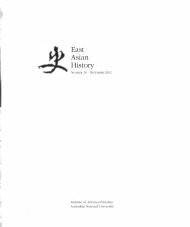Whose Strange Stories? P'u Sung-ling (1640 - East Asian History
Whose Strange Stories? P'u Sung-ling (1640 - East Asian History
Whose Strange Stories? P'u Sung-ling (1640 - East Asian History
You also want an ePaper? Increase the reach of your titles
YUMPU automatically turns print PDFs into web optimized ePapers that Google loves.
6 JOHN MINFORD AND TONG MAN<br />
Figure 9<br />
Single page from the 1842 edition ofLiao-chai<br />
laside, and hoped, believed indeed, that the<br />
light would by and by dawn and that I<br />
should one day get hold of a clue that would<br />
guide me to a knowledge of the mysterious<br />
classic. Before that day came, the translation<br />
was soaked, in 1870, for more than a month<br />
in the water of the Red Sea. By dint of careful<br />
manipulation it was recovered so as to be<br />
still legible; but it was not till 1874 that I<br />
began to be able to give the book the prolonged<br />
attention necessary to make it reveal<br />
its secrets. Then for the first time I got hold,<br />
as I believe, of the clue ... . The written<br />
Icharacters of the Chinese are not representations<br />
of words, but symbols of ideas, and the<br />
combination of them in composition is not a<br />
representation of what the writer would say,<br />
but of what he thinks. It is vain therefore for<br />
a translator to attempt a literal version .<br />
There is not so much an interpretation of the<br />
characters employed by the writer as a<br />
participation of this thoughts;-there is the<br />
seeing of mind to mind." James Legge, Preface<br />
to The texts oJConJucianism, pt Il: the YiKing,<br />
1882.<br />
vivi-section attempts to recreate some of the features<br />
of an unusual reading experience, to build a new<br />
environment that approximates the richness of the<br />
original. <strong>P'u</strong> <strong>Sung</strong>-<strong>ling</strong> wrote for his fellow literati in<br />
a dense, lyrical style, choosing his words with infin<br />
ite care, aware of the resonance of evelY word and<br />
phrase. He was speaking to readers steeped in a<br />
culture made up of layer upon layer of associated<br />
texts and memories, where a thousand assumptions,<br />
attitudes and allusions could be taken for granted<br />
and played upon, because they were shared. One<br />
of the high places of this culture was the Studio, the<br />
chai . , inner sanctum of traditional male leisure.<br />
This new many-layered textual structure is a reinstallation,<br />
a new space for reading that seeks in its<br />
own way to emulate the environment of a Chinese<br />
Studio.<br />
In the central hall stands Giles' <strong>Strange</strong> Story,<br />
with whatever emendations and additions have<br />
seemed necessary to make Giles complete (suitably<br />
marked by typographical or punctuation devices).<br />
This central space has been divided into vertical<br />
sections with lattice patterns taken from Daniel<br />
Sheets Dye's Grammar of Chinese Lattice7<br />
In the centre (of the double page), in the inner<br />
chamber, are a variety of visual reminders of the<br />
Studio environment: the desk is strewn with<br />
inkstones, calligraphy brushes, strange scholarly<br />
knick -knacks of one sort or another, Chinese characters<br />
in variolls styles, and seals (especially seals<br />
carved by or for <strong>P'u</strong> <strong>Sung</strong>-<strong>ling</strong>'s contemporaries, the<br />
sort of people who might have enjoyed the <strong>Stories</strong><br />
as he intended them). Screens and walls are hung<br />
7 Harvard University Press, 1937. These<br />
window structures seemed appropriate for<br />
the job in hand. This "Iatticization" of the<br />
translation (the use of see-through partitions,<br />
rather than walls) is in fact closer to the<br />
structure of the undivided, unpunctuated<br />
Chinese original than Giles' long ramb<strong>ling</strong><br />
paragraphs. It also helps (together with its<br />
section titles) to throw light on what is rather<br />
a complicated plot, involving multiple identities<br />
and incarnations. ("Translation it is that<br />
letteth in the light," Translators' Preface to the<br />
King James Bible.)

















